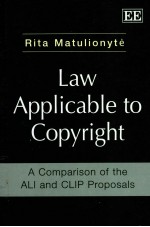

LAW APPLICABLE TO COPYRIGHTPDF电子书下载
- 电子书积分:11 积分如何计算积分?
- 作 者:RITA MATULIONYTE
- 出 版 社:EDWARD ELGAR
- 出版年份:2011
- ISBN:0857934287
- 页数:275 页
1. Introduction 1
A. Background 1
B. Problems 4
C. Goal and scope 5
D. Methodology and structure 7
GENERAL PART:STATUS QUO 11
2. Main rules 13
A. Territoriality principle 13
Ⅰ. Concept 13
Ⅱ. Legal source 17
Ⅲ. Justification 19
Ⅳ. Scope 22
Ⅴ. Relation to lex loci protectionis 25
Ⅵ. Interim conclusions 27
B. Lex loci protectionis 28
Ⅰ. Legal sources 28
Ⅱ. Scope 43
Ⅲ. Distinction from lex loci delicti (commissi) 58
Ⅳ. Interim conclusions 61
C. Substantive law doctrines 62
Ⅰ. Relevance 62
Ⅱ. Emission theory 64
Ⅲ. Bogsch theory 65
Ⅳ. Effect theory 66
Ⅴ. Root-copy approach 71
Ⅵ. Interim conclusions 72
3. Evaluation and alternatives 74
A. Traditional infringements 74
Ⅰ. Lex loci protectionis 75
Ⅱ. Lex originis 80
Ⅲ. Root-copy approach 84
B. Broadcasting infringements 87
Ⅰ. Emission theory 87
Ⅱ. Bogsch theory 91
Ⅲ. Effect theory 96
C. Internet infringements 98
Ⅰ. Bogsch theory 99
Ⅱ. Effect theory 108
Ⅲ. Emission and country of establishment theories 111
D. Interim conclusions 116
SPECIFIC PART:ALI AND CLIP PROPOSALS 119
4. Introduction to the ALI and CLIP Proposals 121
A. Institutional framework 121
B. Development 122
C. Legal status and impact 123
D. Content 123
E. General evaluation 124
5. Lex loci protectionis and the territoriality principle 126
A. Rule and its origin 126
B. Main features 128
Ⅰ. Content 128
Ⅱ. Issues covered 129
Ⅲ. Types of infringements covered 131
Ⅳ. Exceptions 132
C. Evaluation 133
Ⅰ. General 133
Ⅱ. Traditional infringements 138
Ⅲ. Broadcasting infringements 140
D. Proposals 142
Ⅰ. Facilitating enforcement of piracy cases 142
Ⅱ. Dealing with extraterritorial and overlapping remedies 142
E. Interim conclusions 145
6. De minimis rule 146
A. Rule and its origin 146
B. Main features 148
Ⅰ. Legal nature 148
Ⅱ. Content 150
Ⅲ. Scope 155
Ⅳ. Exception 156
C. Evaluation 158
Ⅰ. General 158
Ⅱ. Internet infringements 158
Ⅲ. Broadcasting infringements 160
Ⅳ. Traditional infringements 162
D. Proposals 163
Ⅰ. Elimination of 'action' 164
Ⅱ. Specification of 'effects' 164
Ⅲ. Clarification of relation to the EC Satellite and Cable Directive 165
E. Interim conclusions 165
7. Ubiquitous infringements rule 166
A. Rule and its origin 167
Ⅰ. Content 167
Ⅱ. Origin 168
Ⅲ. Development 170
B. Main features 171
Ⅰ. Close(st) connection rule 171
Ⅱ. Methodology 173
Ⅲ. Scope 178
Ⅳ. 'Retreat to territoriality' exception 183
C. Evaluation 187
Ⅰ. General 187
Ⅱ. Internet infringements 188
Ⅲ. Broadcasting and traditional infringements 193
D. Proposals 195
Ⅰ. Streamlining the closest connection rule 195
Ⅱ. Specifying connecting factors 196
Ⅲ. Extending the scope 199
Ⅳ. 'Retreat to territoriality' exception 200
Ⅴ. Remedies 201
E. Interim conclusions 202
8. Initial ownership 203
A. Rule and its development 204
B. Main features 205
Ⅰ. Single ownership 205
Ⅱ. Co-ownership relationship 208
Ⅲ. Employment relationship 210
C. Evaluation 214
Ⅰ. General 214
Ⅱ. Single-ownership rule 214
Ⅲ. Co-ownership 217
Ⅳ. Employment relationship 220
D. Proposals 226
Ⅰ. Two-step approach 226
Ⅱ. 'Retreat to territoriality' exception 227
E. Interim conclusions 228
9. Party autonomy 230
A. Rule and its origin 231
B. Main features 232
Ⅰ. Absolute party autonomy 232
Ⅱ. Ex ante and ex post agreements 233
Ⅲ. Scope of choice 234
C. Evaluation 235
Ⅰ. General 235
Ⅱ. Territoriality concerns 236
Ⅲ. Effectiveness 236
D. Proposals 238
E. Interim conclusions 239
10. Conclusions 240
Bibliography 244
Index 265
- 《心理咨询面谈技术 第4版》(美)JOHN SOMMERS-FLANAGAN,RITA SOMMERS-FLANAGAN著;陈祉研,江兰,黄峥译 2014
- 《拖沓的孩子 根除影响孩子一生的坏习惯》(美)丽塔·埃米特(Rita Emmett)著;宋苗译 2004
- 《大脑的秘密档案》(英)丽塔·卡特(Rita 2002
- 《路由与交换》Rita Puzmanova著;黄永峰,周可等译 2004
- 《ENVIRONMENTAL SECURITY:APPROACHES AND ISSUES》RITA 2222
- 《NURSING MANAGEMENT OF EPILEPSY》RITA BECK BLACK 1982
- 《LIVING WITH ART FOURTH EDITION》RITA GILBERT 1994
- 《HANDBOOK OF NEONATOLOGY SECOND EDITION》RITA G.HARPER 2222
- 《NOMINATION AND ELECTION OF THE PRESIDENT AND VICE PRESIDENT OF THE UNITED STATES》THOMAS M.DURBIN RITA ANN REIMER 1976
- 《CAROTID ARTERY DISEASE FROM BEDSIDE AND BEYOND》RITA REZZANI 2014
- 《The Elgar Companion to the Chicago School of Economics》Emmett 2010
- 《ELGAR》SIMON MUNDY 2222
- 《EDWARD ELGAR A CREATIVE LIFE》 2222
- 《THE ELGAR COMPANION TO PUBLIC CHOICE SECOND EDITION》MICHAEL REKSULAK LAURA RAZZOLINI WILLIAM F.SHUGHART II 2013
- 《THE CAMBRIDGE COMPANION TO ELGAR》DANIEL M GRIMLEY AND JULIAN BUSHTON 2004
- 《THE ELGAR COMPANION TO MARXIST ECONOMICS》BEN FINE 2012
- 《亚洲的减贫奇迹 成就斐然还是未竟之业?》(以)雅克·西尔伯;万广华编 2017
